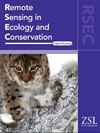UAVs unveil the role of small scale vegetation structure on wader nest survival
IF 4.3
2区 环境科学与生态学
Q1 ECOLOGY
引用次数: 0
Abstract
Several ground‐nesting wader species rely on Baltic coastal meadows for breeding. Drastic reduction in the area of the habitat at the end of the 20th century has been followed by habitat restoration activities over the last 20 years. However, wader populations are not responding as hoped to the current conservation effort. Therefore, identifying which grassland characteristics are essential for waders to select their nesting location and which ones enhance their clutch survival probability is vital to implementing efficient conservation plans. However, many vegetation structural characteristics, such as sward height or heterogeneity, can be logistically complex to measure using traditional methods in relatively large areas, especially considering the highly accurate resolution needed. Here, we assessed several sward characteristics together with other key landscape features by combining very high‐resolution images from unmanned aerial vehicle (UAV) surveys with nest survival monitoring, in five key Estonian coastal grasslands for waders. We found that the main four wader species, Northern Lapwing (无人机揭示了小尺度植被结构对涉禽巢生存的作用
一些地面筑巢的涉禽物种依靠波罗的海沿岸的草甸繁殖。在20世纪末栖息地面积急剧减少之后,在过去20年中进行了栖息地恢复活动。然而,对目前的保护工作,涉水动物数量的反应并不如人们所希望的那样。因此,确定哪些草原特征对涉禽选择筑巢地点至关重要,哪些特征能提高其窝群存活率,对于实施有效的保护计划至关重要。然而,许多植被结构特征,如草地高度或异质性,在相对较大的区域使用传统方法测量可能非常复杂,特别是考虑到所需的高精度分辨率。在这里,我们通过将无人机(UAV)调查的高分辨率图像与巢生存监测相结合,评估了爱沙尼亚五个主要的涉水动物沿海草原的几个特征以及其他主要景观特征。研究发现,北田凫(Vanellus Vanellus)、普通红脚鹬(Tringa totanus)、普通环鸻(Charadrius hiaticula)和波罗的海鸻(Calidris alpina schinzii)这四种主要的水禽物种在筑巢地点的选择上,在植被高度、生长速率或草地异质性方面没有显著差异。然而,我们发现,在2米缓冲区内,巢址周围植被的高度和异质性正增加了巢的日存活率,从0.883增加到0.979。巢位与淹水面积(≥20m2)之间的距离呈负相关,各变量对涉禽群落的影响相似。我们的研究结果表明,爱沙尼亚沿海草甸需要更高多样性的草地结构,以及不断被淹没的地区的重要性。此外,我们的研究强调了将无人机遥感技术整合到动物保护研究领域的重要性,以揭示使用更传统方法可能仍然隐藏的生态模式。
本文章由计算机程序翻译,如有差异,请以英文原文为准。
求助全文
约1分钟内获得全文
求助全文
来源期刊

Remote Sensing in Ecology and Conservation
Earth and Planetary Sciences-Computers in Earth Sciences
CiteScore
9.80
自引率
5.50%
发文量
69
审稿时长
18 weeks
期刊介绍:
emote Sensing in Ecology and Conservation provides a forum for rapid, peer-reviewed publication of novel, multidisciplinary research at the interface between remote sensing science and ecology and conservation. The journal prioritizes findings that advance the scientific basis of ecology and conservation, promoting the development of remote-sensing based methods relevant to the management of land use and biological systems at all levels, from populations and species to ecosystems and biomes. The journal defines remote sensing in its broadest sense, including data acquisition by hand-held and fixed ground-based sensors, such as camera traps and acoustic recorders, and sensors on airplanes and satellites. The intended journal’s audience includes ecologists, conservation scientists, policy makers, managers of terrestrial and aquatic systems, remote sensing scientists, and students.
Remote Sensing in Ecology and Conservation is a fully open access journal from Wiley and the Zoological Society of London. Remote sensing has enormous potential as to provide information on the state of, and pressures on, biological diversity and ecosystem services, at multiple spatial and temporal scales. This new publication provides a forum for multidisciplinary research in remote sensing science, ecological research and conservation science.
 求助内容:
求助内容: 应助结果提醒方式:
应助结果提醒方式:


